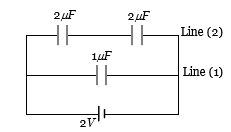Physics-
General
Easy
Question
The charge on any one of the  capacitors and
capacitors and  capacitor will be given respectively (in
capacitor will be given respectively (in  ) as
) as

- 1, 2
- 2, 1
- 1, 1
- 2, 2
The correct answer is: 2, 2
Potential difference across both the lines is same i.e. 2 V. Hence charge flowing in line 2

 So charge on each capacitor in line (2) is 2 mC
So charge on each capacitor in line (2) is 2 mC
Related Questions to study
Physics-
Two capacitors C1 and C2 = 2C1 are connected in a circuit with a switch between them as shown in the figure. Initially the switch is open and C1 holds charge Q. The switch is closed. At steady state, the charge on each capacitor will be

Two capacitors C1 and C2 = 2C1 are connected in a circuit with a switch between them as shown in the figure. Initially the switch is open and C1 holds charge Q. The switch is closed. At steady state, the charge on each capacitor will be

Physics-General
Physics-
In the given figure the capacitors  have a capacitance 4
have a capacitance 4  each if the capacitor C2 has a capacitance 10
each if the capacitor C2 has a capacitance 10  , then effective capacitance between A and B will be
, then effective capacitance between A and B will be

In the given figure the capacitors  have a capacitance 4
have a capacitance 4  each if the capacitor C2 has a capacitance 10
each if the capacitor C2 has a capacitance 10  , then effective capacitance between A and B will be
, then effective capacitance between A and B will be

Physics-General
Physics-
The effective capacity between A and B in the figure given is

The effective capacity between A and B in the figure given is

Physics-General
Physics-
The equivalent capacitance between A and B is

The equivalent capacitance between A and B is

Physics-General
Physics-
The equivalent capacitance in the circuit between A and B will be

The equivalent capacitance in the circuit between A and B will be

Physics-General
Physics-
A parallel plate capacitor has capacitance C. If it is equally filled with parallel layers of materials of dielectric constants K1 and K2 its capacity becomes C1. The ratio of C1 to C is
A parallel plate capacitor has capacitance C. If it is equally filled with parallel layers of materials of dielectric constants K1 and K2 its capacity becomes C1. The ratio of C1 to C is
Physics-General
Maths-
A tangent to the curve, Y=f(x) at P(x, Y) meets X‐axis at A and Y‐axis at B If AP:BP=1: 3 and f(1)=1, then the curve also passes through the point
A tangent to the curve, Y=f(x) at P(x, Y) meets X‐axis at A and Y‐axis at B If AP:BP=1: 3 and f(1)=1, then the curve also passes through the point
Maths-General
Maths-
The abscissa of a point on the curve XY=(a+x)2, the normal at which the cuts off numerically equal intercepts from the coordinate axes is
The abscissa of a point on the curve XY=(a+x)2, the normal at which the cuts off numerically equal intercepts from the coordinate axes is
Maths-General
Maths-
In mean value theorem  and f(x)=x(x-1)(x-2) ,the value of
and f(x)=x(x-1)(x-2) ,the value of  is
is
In mean value theorem  and f(x)=x(x-1)(x-2) ,the value of
and f(x)=x(x-1)(x-2) ,the value of  is
is
Maths-General
Maths-
Rolle’s theorem is not applicable tto the function  defined on [−1, 1] because
defined on [−1, 1] because
Rolle’s theorem is not applicable tto the function  defined on [−1, 1] because
defined on [−1, 1] because
Maths-General
Maths-
If  , then the minimum value of ax+by is
, then the minimum value of ax+by is
If  , then the minimum value of ax+by is
, then the minimum value of ax+by is
Maths-General
Chemistry-
The compound that will react most readily with NaOH to form methanol is:
The compound that will react most readily with NaOH to form methanol is:
Chemistry-General
Chemistry-
The order of reactivity of the following alcohols towards conc. HCl is:
I) 
II) 
III) 
IV) 
The order of reactivity of the following alcohols towards conc. HCl is:
I) 
II) 
III) 
IV) 
Chemistry-General
Chemistry-
How many optically active stereo isomers are possible for butan-2,3-diol?
How many optically active stereo isomers are possible for butan-2,3-diol?
Chemistry-General
Chemistry-
In reaction sequence,

molecule M and reagent R, respectively, are:
In reaction sequence,

molecule M and reagent R, respectively, are:
Chemistry-General





